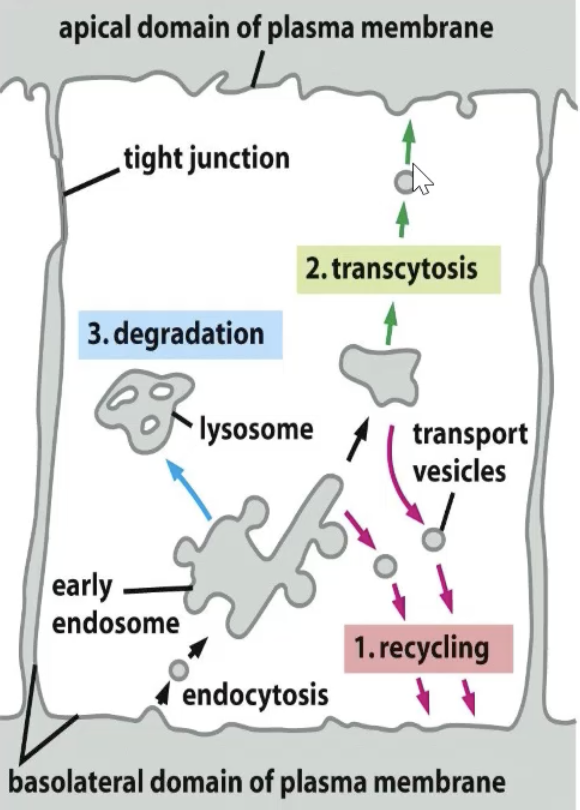BSCI330: Vesicular Transport
1/44
There's no tags or description
Looks like no tags are added yet.
Name | Mastery | Learn | Test | Matching | Spaced |
|---|
No study sessions yet.
45 Terms
What is vesicular transport?
Travel between compartments in the cell via vesicles that fuse with their targets!
Works only with topologically similar compartments that are membrane enclosed.
What are coat proteins for?
For initial source and destination identification!
Clathrin: golgi, endosomal compartments, plasma membrane
COP I: within golgi AND golgi to ER AND golgi to plasma membrane (via vesicles)
COP II: ER to golgi
How do coat proteins work?
Cause the membrane of the original compartment to deform into an outbudding (force curvature for small vesicle)! Form a cage around the vesicle.
What needs to happen before fusion?
Uncoating of vesicle!
How do coat proteins know where to bind?
Proteins in the membrane that serve as receptors or identifers of the membrane (coat proteins interact with these)
OR
Lipids in membrane that can be modified by phosphorylation!
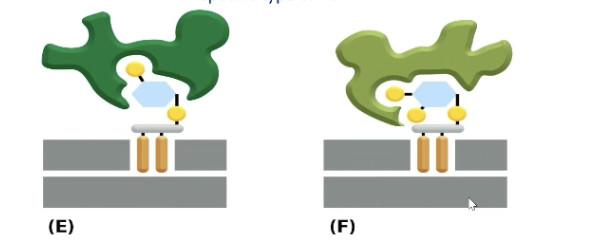
What is phosphorylation of inositols?
ORGANIZING PRINCIPLE FOR TRAFFICKING OF PROTEINS
Inositols get phosphorylated at various locations by lipid kinases.
Seven different combinations of phosphorylation at 3 locations (carbons 3,4,5). Each one recognized by a different lipid binding domain/protein.
Each membrane can have its own distribution of phosphoinositids, to identify donor and target membranes.
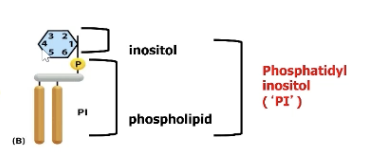
Where do coat proteins bind?
Coat proteins do not bind to target membranes, but adaptor proteins that recognize something in the membrane like cargo receptors (tell what’s in the cargo)
How do GTPases control coat assembly?
GTP bound can interact with target membrane and help recruit coat proteins
GDP bound allows for disassembly of coat
What are other GTP binding proteins that regulate trafficking?
Monomeric GTPases regulate many steps in vesicular traffic
Sar-1 regulates COPII assembly
Arf regulates COPI and clathrin assembly
What does the Sar1 GTP-ase work as?
It works as a GEF!
Ampipathic helix is exposed in hydrolysis of GDP to GTP in soluble.
Hydrophobic face inserts into outer leaflet of organelle/membrane—acts as an on switch to activate coat recruitment.

What is necessary for docking and targeting?
Must be able to recognize correct target membrane to fuse!
Surface markers to indicate origination and type of cargo!
Target membranes display complementary receptors to recognize appropriate markers!
What are two classes of markers that aid in recognition of donor vesicles by acceptor membranes?
SNAREs and Rabs
What are SNAREs?
Catch the vesicles!
Two component system (v-SNARE and t-SNARE).
Force generation drives the membranes to fuse.
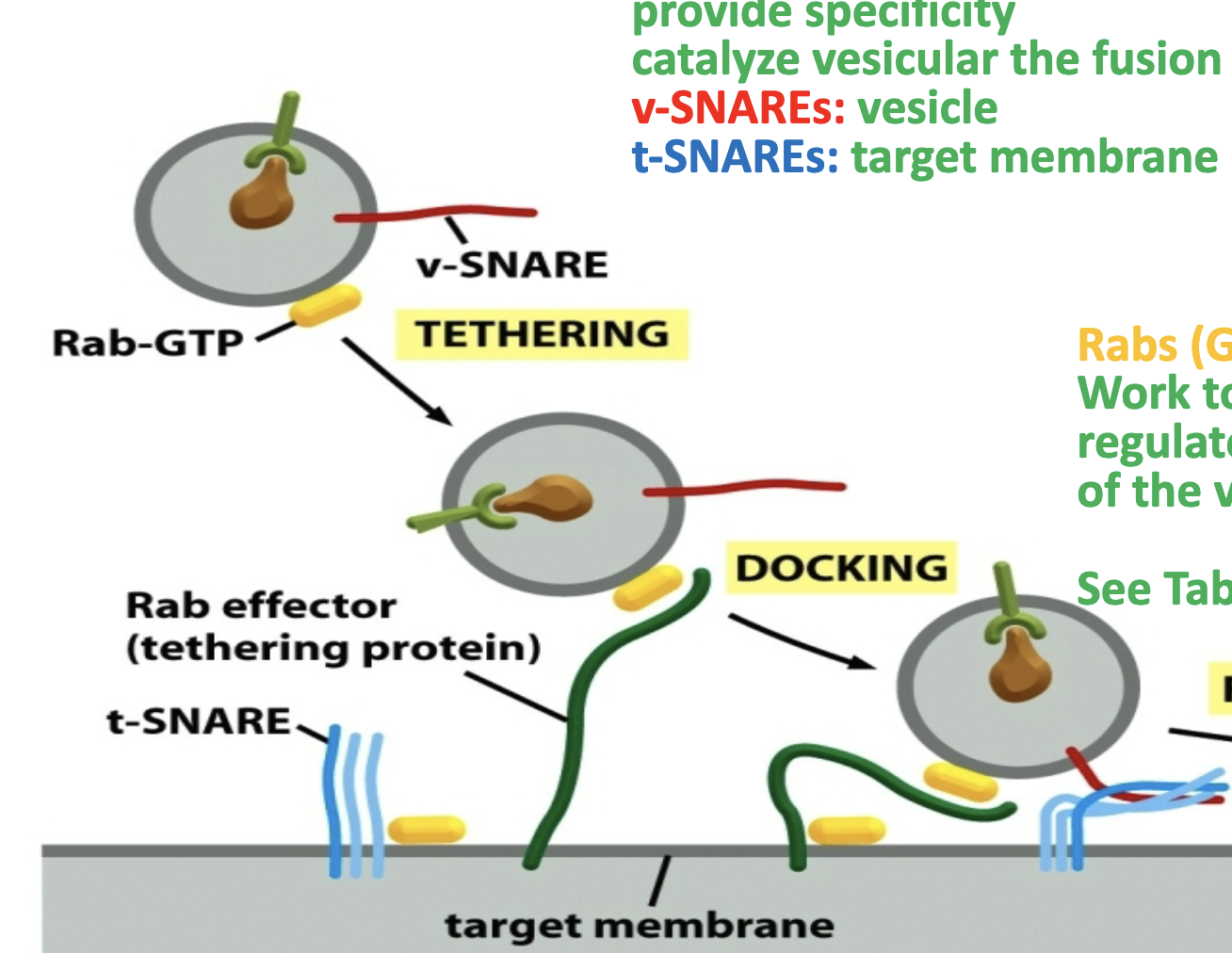
What are Rabs?
Type of GTPases1
GTP bound form can interact with tethering protein to make a connection with the vesicle!
pulls vesicle towards the target membrane
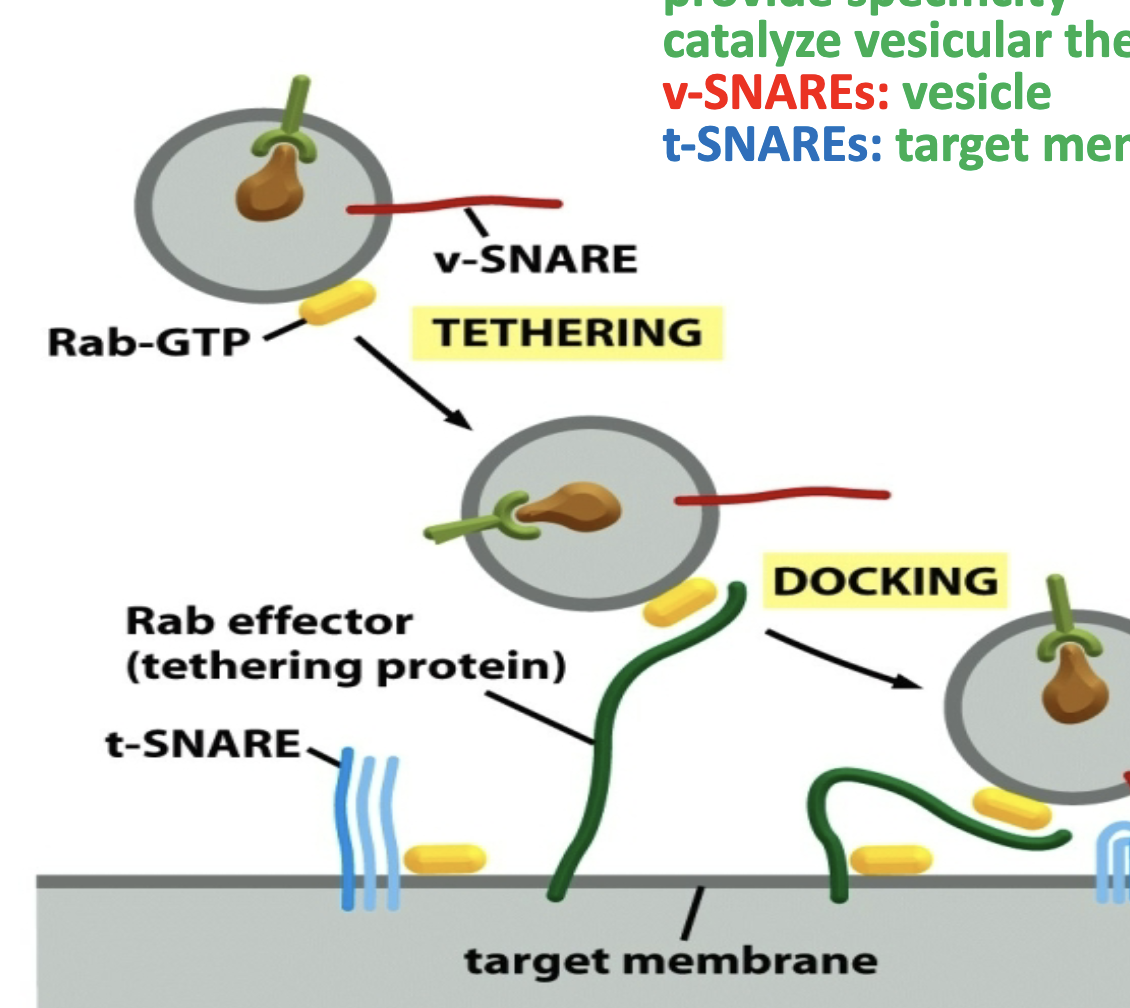
What causes fusion?
If correct v-SNARE and t-SNARE bind when vesicle starts docking!
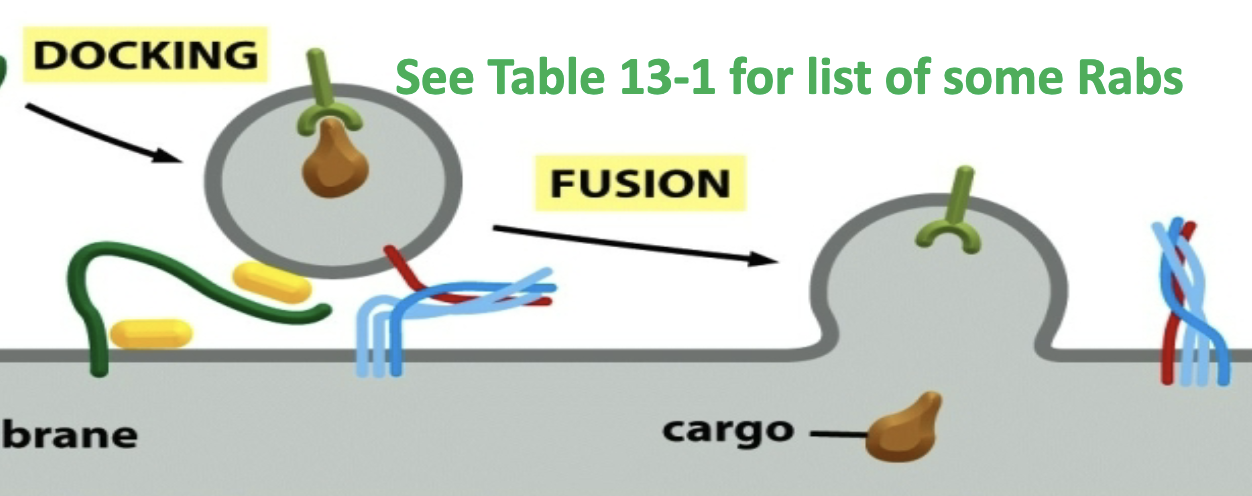
How does cargo recruitment work?
Must be able to recrit cargo.
Transmembrane protein that needs to leave ER, will have exit signals in their cytosolic ‘tails’ that are recognized by coat proteins
Soluble proteins bind to cargo receptors that have exit signals in their tails; receptors get returned
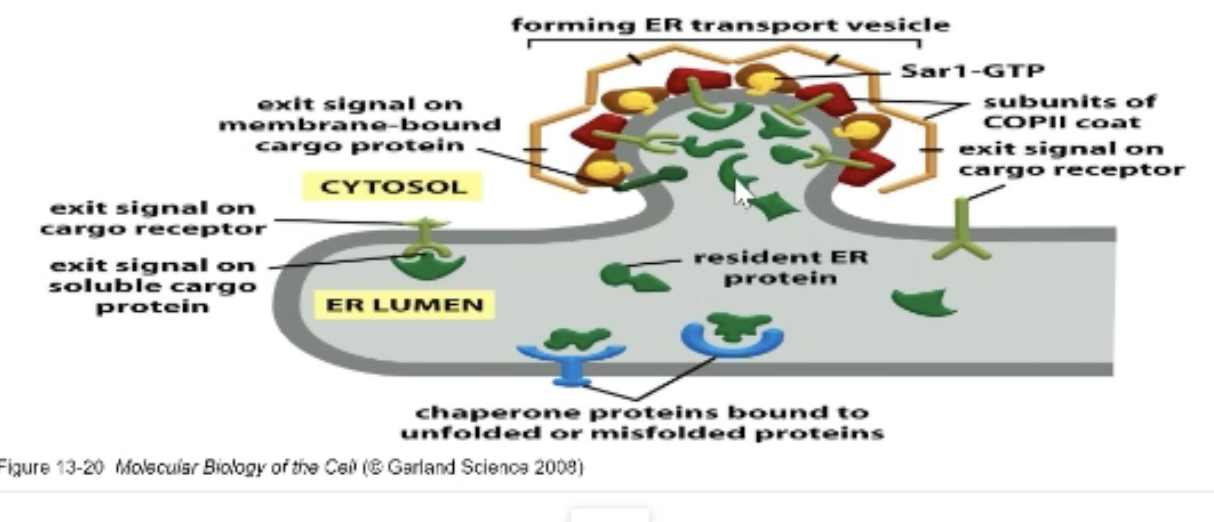
What are vesicular tubular clusters?
Transport vesicles leaving the ER that fuse together.
Travel towards the cis Golgi (closest to ER) via motor proteins on microtubule track.
proteins need to be returned back bud off with COP I and retrograde transport
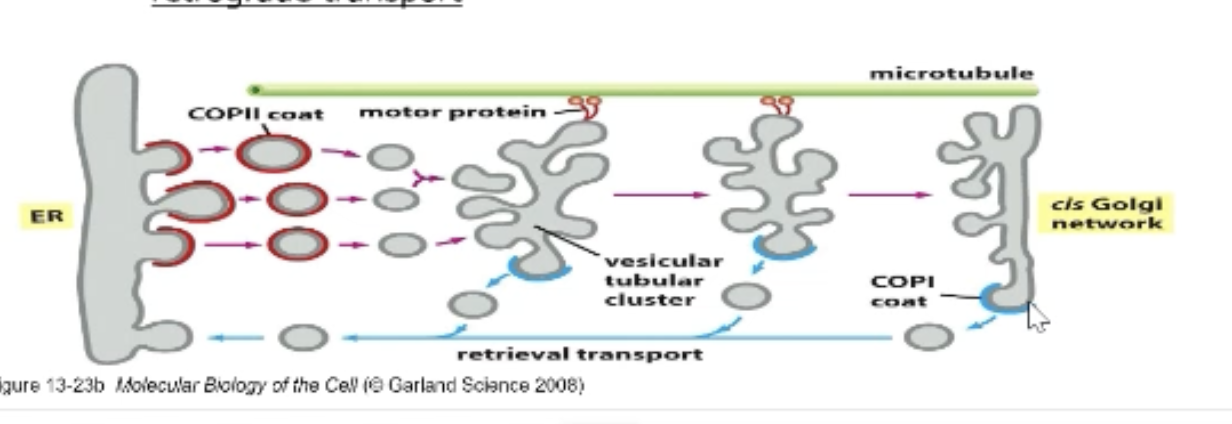
How does going back to the ER work?
Transmembrane proteins will have retrieval signals in their cytosolic tails (recognized by COP I)
Soluble ER proteins will have retrieval signals that bind to cargo retrieval receptors (ex. KDEL signals)
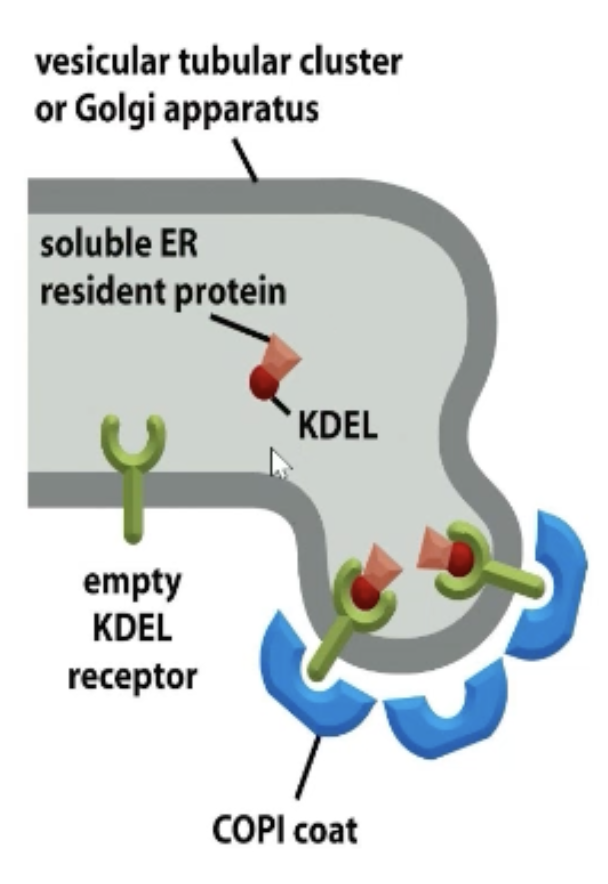
What is the KDEL sequence?
A famous retrieval sequence!
Lysine, aspartic acid, glutamic acid, leucine
If found in a soluble protein (caught in a vesicle) will be returned to the ER.
What are the two current models for cargo travel through the golgi (cis to trans)?
1) Vesicular Transport Model
2) Cisternal Maturation Model
Explain the vesicular transport model
AKA STATIC Transport Model.
Golgi stack (cisternae) stays UNIFORM!
Movement thru transport vesicles in forward and retrograde direction.
Explain the cisternal maturation model
Cisternae are DYNAMIC
When vesicular tubular clusters approach the cis golgi network, it becomes the new CGN.
CGN matures into cis cisterna, which becomes the new medial cisterna and so on until it becomes the new TGN.
Old TGN buds off (we lose membrane at this end).
Whole cisternae matures.
Analogies for vesicular and cisternal maturation transport models?
Vesicular transport is an elevator model! The elevator is a vesicle.
Cisternal transport involves the reconstruction of a new basement that lifts up everything else! Top floor flies off (every floor moves up).
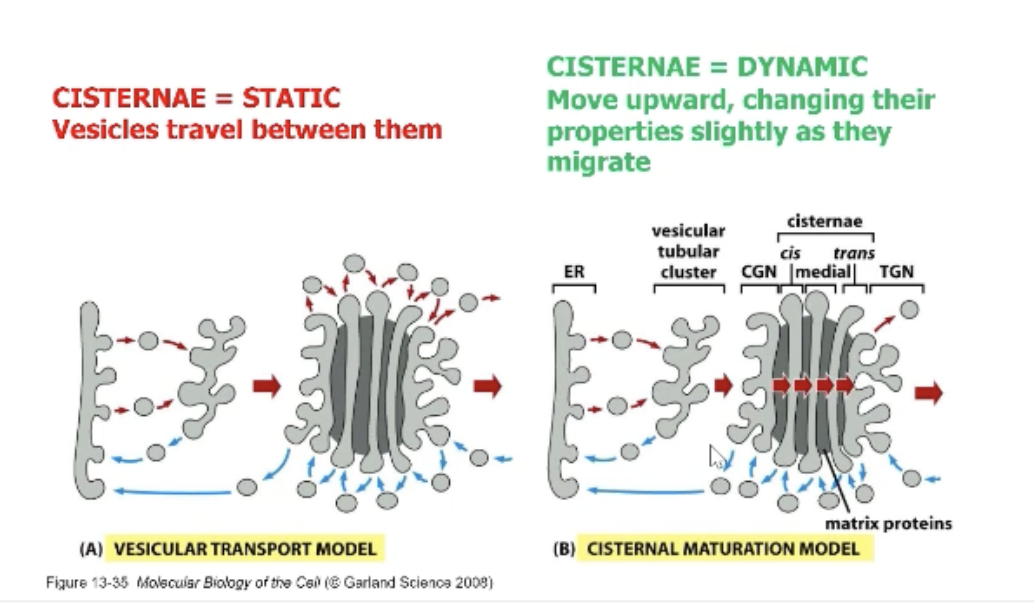
What is exocytosis?
Fusing of the vesicle with the plamsa membrane to exit.
Usually vesicles carrying: membrane proteins, lipids (for the membrane), soluble proteins (for extracellular space)
Two modes of secretion?
Constitutive secretory pathway
Regulated secretory pathway
What is the constitutive secretory pathway?
DOES NOT require an additional signal for fusion of the plasma membrane with the vesicle.
What is the regulated secretory pathway?
Usage of secretory vesicles (concentrate cargo into small volume AND do NOT fuse immediately)
RABs recognize docking protein, but SNAREs don’t go. There must be a signal to induce secretion (ex. nerve signal).
Signal often involves calcium flux.
What are clathrin-coated vesicles?
Usually from plasma membrane to internal compartments (endosomal system) and golgi.
First coat protein to be identified (composed of 3 copies of heavy chain and light chain arranged in a 3 armed PINWHEEL—triskelion)!
Assembles on plasma membrane, pits will form that pinch off and clathrin then decoats.
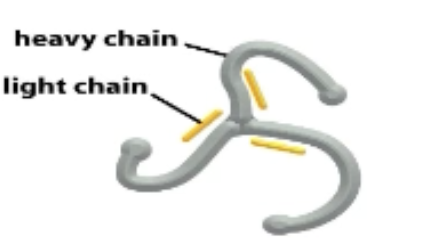
What is involved in clathrin coat formation?
Clathrin, adpator proteins, and transmembrane cargo receptors.
Clathrin is recruited via adapter proteins that interact with transmembrane receptors.
They capture and package cargo molecules within the donor compartment into budding vesicle.
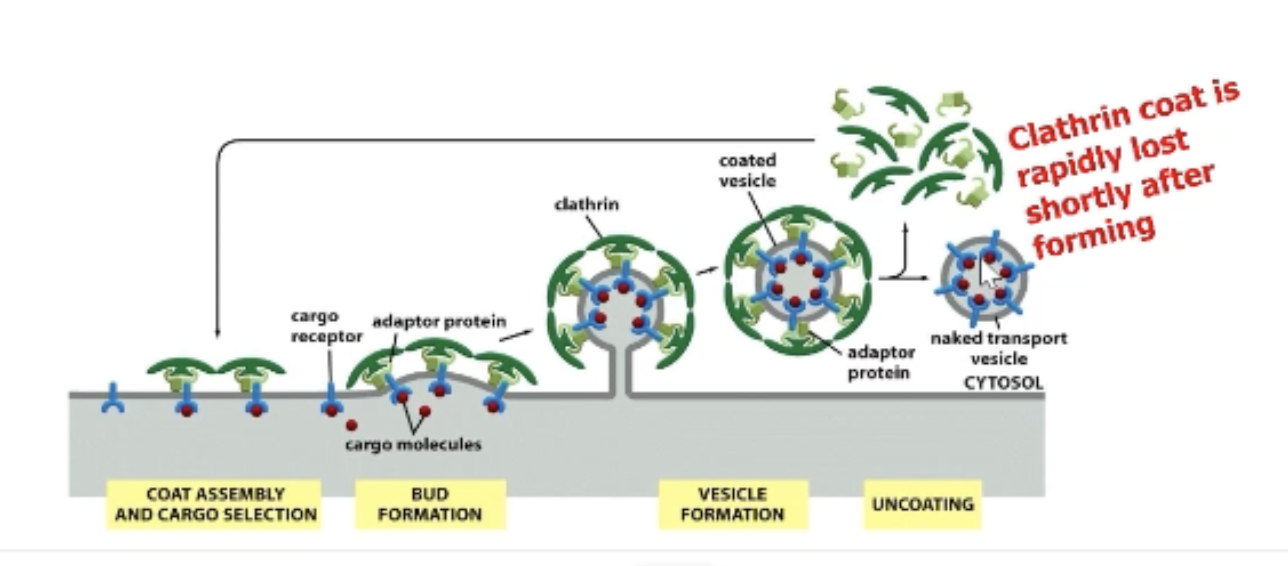
How does budding off occur?
Use dynamin!
Dynamin (a GTP binding protein) wraps around the stem of the budding vesicle to form a helical oligomer (oligomerizes).
Dynamin hydrolyzes GTP causing conformation change → helix squeezes causing the pinching off of the Clathrin vesicle.
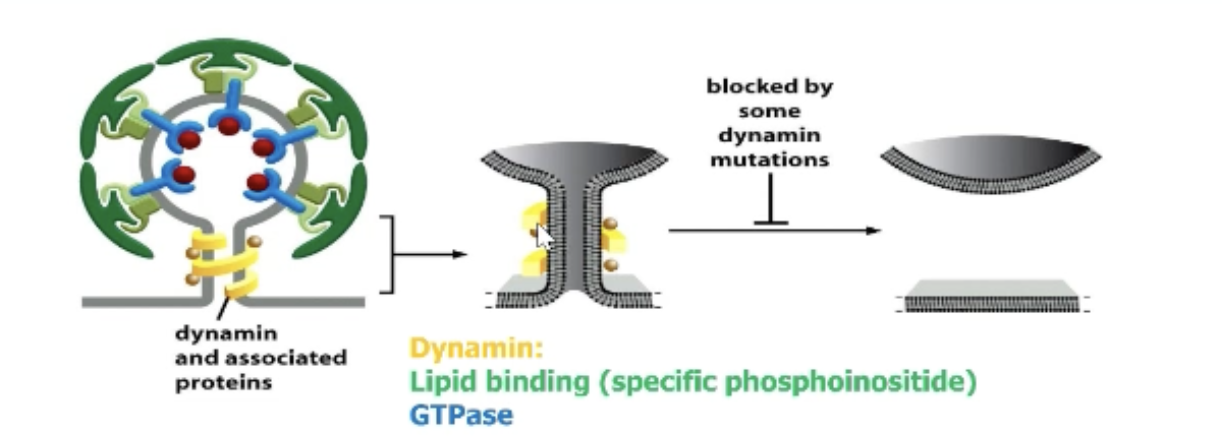
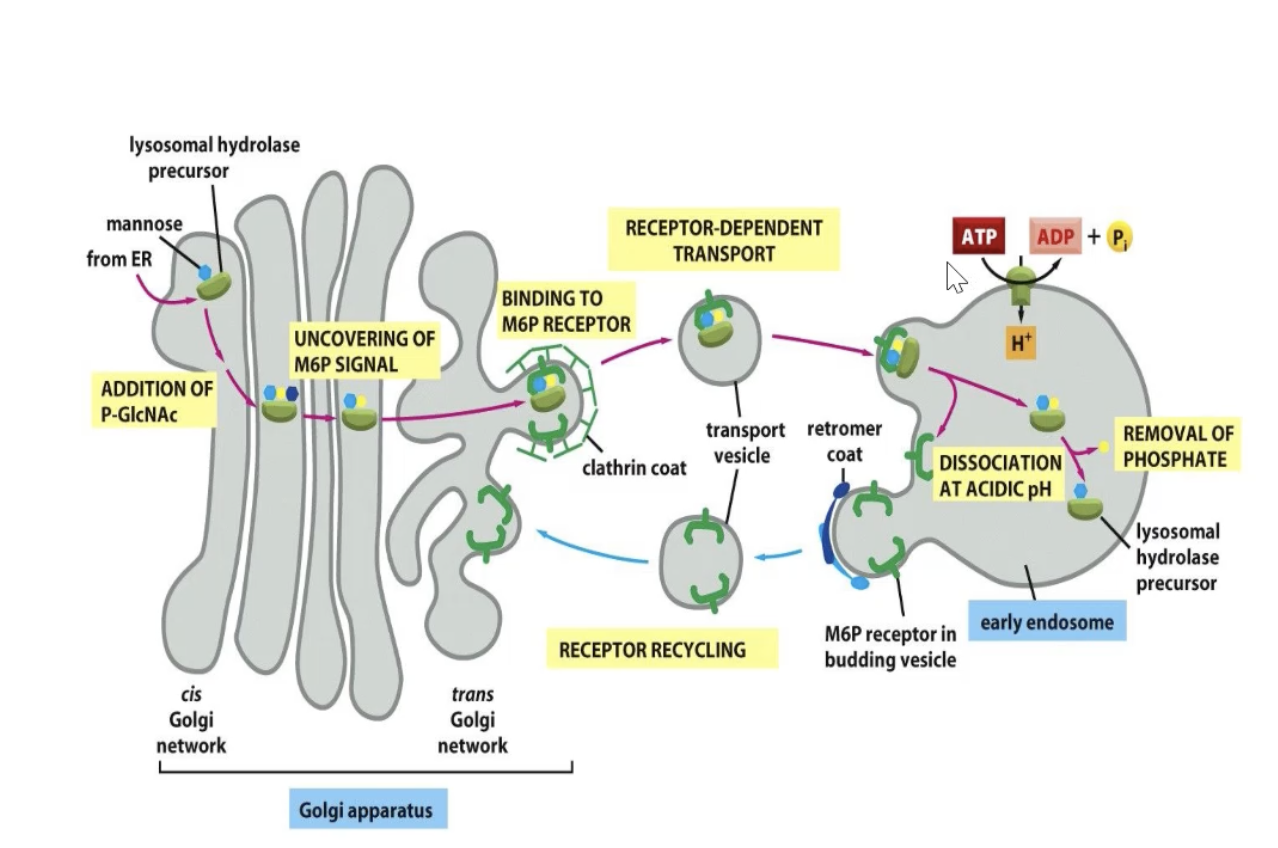
How do we get lysosomal enzymes to the lysosomes?
In lysosomes you have hydrolytic enzymes for degradation! Need a way to get this cargo to lysosomes.
Soluble enzymes in lysosomes have their own targeting signal! MANNOSE 6-PHOSPHATE (M6P)
M6P recruits proteins to lysosomes.
Recognized by the trans golgi network (TGN) and packaged into clathrin coated vesicles for delivery to lysosomes.
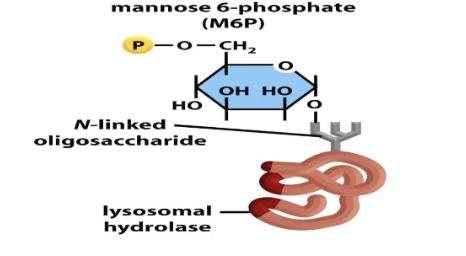
What does the retrograde transport from lysosomes to golgi use?
Retromer (a dimeric protein)!
NOT A mediated by a full protein (cage) coat.
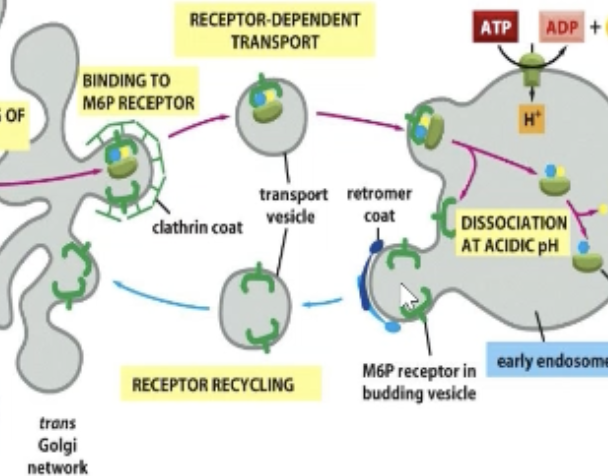
Which step of vesicle transport does not involve a GTPase?
Fusion of the vesicle membrane with the target organelle
Which GTP-binding proteins regulate the assembly of the coat?
Arf and SAR-1
Which GTP-binding proteins regulate targeting?
Rabs
What regulates SNAREs?
ATP! ATP hydrolysis sets v and t SNARE into spring loaded situation!
What endosomal compartments?
Intermediate transient compartments that appear in endocytosis/ largely for transit to lysosomes
vary in size and shape
receive cargo from golgi and plasma membrane
Three major classes: early, late recycling (recycle receptors back to cell surface)
How do early endosomes mature into late endosomes?
They become acidic! Proton pumps will pump protons from cytosol into lumen.
Late endosomes can endocytose their own membrane (noted by smaller vesicles).
Late endosomes can fuse into lysosomes.
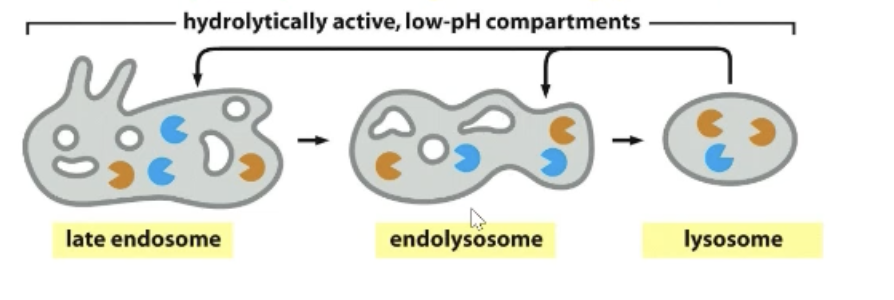
What are multivesicular bodies?
The small vesicles in endosomes! Vesicles within vesicles—way for membrane lipids to be degraded.
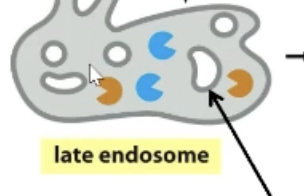
What is endocytosis?
Membrane proteins and lipids that come off the plasma membrane AND soluble proteins for degradation are cargo!
Cargo is either: recycled OR degraded
What are the three types of endocytosis?
Phagocytosis (“cellular eating”) —large particles
Pinocytosis (“cellular drinking”) — fluid and solutes
Transcytosis — polarized cells
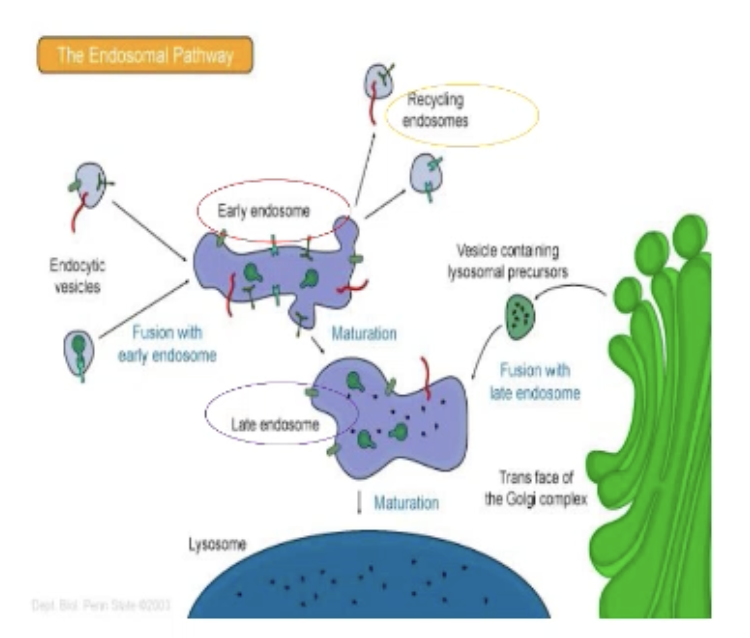
Difference between phagocytosis and pinocytosis?
The size of the phagosome is dependent on the particle being taken in, but in pinocytosis, the size is standardized (always the same).
What is a special case of pinocytosis?
Receptor-mediated endocytosis!
Generally a fluid phase endocytosis (continuous, NO signal), so in receptor-mediated it is only triggered by a signal (from cell communication or nutrient uptake).
How do we determine what is sent to degradation in the lysosome and what is recycled?
Cell segregates different receptors…
Cell communication receptor → degraded
Cell importer receptor → recycled
What is transcytosis?
For polarized cells, where there are two surfaces of cells exposed to different environments (apical and basolateral).
Cells have junctions that separate the two environments (prevent diffusion of fluids).
1) Endocytosis from one end of cell
2) Recycling cells get receptors back to the membrane they came from
3) Cargo is recycled to the other side to fuse with plasma membrane
Cell recognizes it has two different surfaces (ex. gut and blood stream). NOT DIFFUSION (unregulated).
